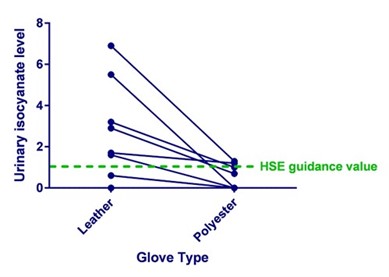Skin absorption of isocyanates: Use of MDI adhesive
The Challenge
During the manufacture of industrial flooring, chipboard panels
were coated with isocyanate-based adhesive (MDI, methyl diphenyl
diisocyanate) before metal facing plates were manually attached to
either side. The panel was then mechanically crimped prior to being
manually taken off the production line for storage. The
workers were wearing leather gloves, primarily for protection
against physical injury during the manual tasks. Urine samples
showed that body burdens for MDI substantially exceeded the UK
guidance value in a number of workers.
The Solution
HSE looked at the correlation between airborne MDI and levels
found in urine. This showed that the urine samples indicated
substantially more MDI exposure than expected from the measured air
levels.
In light of this, and the nature of the handling tasks within
the process, it was suspected that skin exposure could be
contributing to the overall body burden. The glove regime was
reviewed and it was decided to replace the leather gloves with
polyester gloves that had a polyurethane palm. These would provide
chemical protection and, being cheaper, could be changed more
frequently. The graph below shows individual worker results for
both the leather and polyester gloves. In virtually all cases, use
of polyester gloves reduced the exposure of the worker to below the
guidance value.

The Outcome
Following the intervention, body burdens were significantly
reduced, with all workers tested showing lower levels in urine.
Whereas three-quarters of the workers exceeded the biological
monitoring guidance value before the intervention, only a quarter
still exceeded it afterwards, and then only marginally. The
airborne levels of MDI remained similar after the intervention,
indicating that dermal contact had been the primary source of
exposure, as suspected.
A straightforward improvement in the glove regime markedly
reduced worker exposure to a potent skin and respiratory
sensitiser, thus reducing the likelihood of future ill-health.
With thanks to Aspen Environmental.
Back to the top